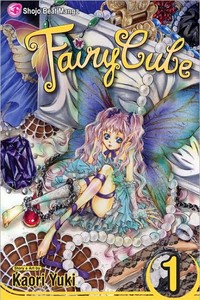Review
by Casey Brienza,Fairy Cube
GN 1
| Synopsis: |  |
||
Do you believe in fairies? Well, Ian Hasumi certainly does—because he can see them with his own eyes. His entire life, a sinister doppelganger named Tokage visible only to himself has been shadowing him. But a gift of a “fairy cube” from mysterious one-eyed shopkeeper named Kaito and is fay sidekick Ainsel soon leads to disaster for Ian, for it grants Tokage the power to take over Ian's body! Now Ian is the shadow, helpless as Tokage lives his life and steals his childhood sweetheart Rin, and if he's ever to get his body and his girl back, he's going to have to play by their fairies' sinister rules…and become a changeling himself. |
|||
| Review: | |||
Veteran shoujo mangaka and confessed Anglophile Kaori Yuki is at it again with a delightful genre-bending mixture of school romance and gothic horror/fantasy. Yuki is best known for her two twisted epics Angel Sanctuary and the Earl Cain series, but she is arguably at her best when circumscribed by a modest page count. Although the single volume Boys Next Door remains, in my opinion, her strongest work to date, Fairy Cube, projected and complete at three volumes, is by no means a shabby competitor. Devoted Yuki fans, of which there are many, will notice many parallels between Fairy Cube and her other works; many of the character types and plot developments are analogous across multiple titles. Yet she also adds a welcome infusion of the novel by drawing upon a rich body of Celtic tradition and fairy lore. She has a distinct talent for bringing to bear the weight of myth upon her plots, and they both deepen and strengthen the original narrative already brought to the table. For example, Changelings are humans whose bodies have been taken over by fairies—predictable enough so far. But Yuki also adds her own sinister twist: the possessed human occasionally proves to be a poor match for the fairy, and the fairy is forced to vacate the body in a deadly, wings-shaped spray of blood that in the manga have become labeled the Fairy Murders by law enforcement assuming a non-supernatural explanation. Quite original, easy for the reader to comprehend, and, most importantly of all, it works for the series. In fact, Fairy Cube's story works, period. The story's controlled pacing its one of its best assets, and the sheer variety of action and locale is deliciously diverse but never too confusing. Ian's story covers an incredible amount of territory in the first two-hundred pages; he lives, he dies, he explores another world, and then he comes back again as someone else. Yet it's all effortlessly fluid and never moves too quickly or too slowly. Nothing—not dialogue, not fight scenes, not background information—takes up too much space. The best storytelling is that which does not draw attention to its own artifice; in this, Yuki is an underappreciated master who is capable of preventing the story from getting away from her, and you can readily believe that this series is going to reach a satisfying conclusion by volume three. Purely from a narrative point of view, this is a most difficult book to put down. Unfortunately, the artwork is, on a visceral level, much less satisfying. Up until this point in the review, I have been referring to Kaori Yuki as the auteur of the manga that bears her name on the cover, but it might be more accurate to take a page of Foucault and talk about “Kaori Yuki” as an author function. For although the story avoids the signature cynicism of a cultural product developed by committee, the illustration does not. Like many successful mangaka, Yuki has an army of assistants at her beck and call, and the resultant stylistic inconsistencies show on every page. It looks like the product of a half-dozen artists, not one, and it is unclear how much of this work is actually Yuki's own. Naturally, none of the assistants are credited, so Yuki, deservingly or no, takes the lion's share of the credit for all of the peons laboring anonymously under her name. Of course, this practice is now a ubiquitous fact of life across the Japanese manga publishing field, and I am perhaps somewhat unusual for being bothered by it. There is no question that, despite this, Fairy Cube's art is quite lovely. Many are captivated by Yuki's stylings and layouts—and rightly so. Her color work in particular is exemplary, and the cover of volume one, which depicts Ainsel in iridescent shades of blue and green, is hands down the most beautiful of any yet to be published under Viz Media's Shojo Beat imprint. Anyway, I highly recommend Fairy Cube to any and all manga fans. Yuki has been honing her craft for over two decades now, and this pretty little gem of a manga is both a worthy addition to her not inconsiderable oeuvre and an excellent introduction to any looking for a modest yet satisfying way into it. |
| Grade: | |||
|
Overall : A-
Story : A
Art : B+
+ Interesting storyline, attractive art, and a modest, manageable scope. |
|||
| discuss this in the forum (7 posts) | | |||
| Production Info: | ||
|
Full encyclopedia details about Release information about |
||